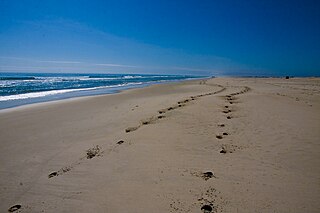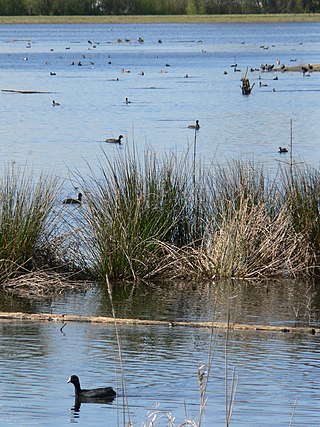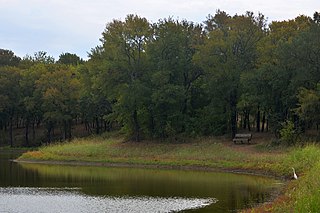Related Research Articles

The Patuxent River is a tributary of the Chesapeake Bay in the state of Maryland. There are three main river drainages for central Maryland: the Potomac River to the west passing through Washington, D.C., the Patapsco River to the northeast passing through Baltimore, and the Patuxent River between the two. The 908-square-mile (2,352 km2) Patuxent watershed had a rapidly growing population of 590,769 in 2000. It is the largest and longest river entirely within Maryland, and its watershed is the largest completely within the state.

Goose Creek State Park is a North Carolina state park near Washington, Beaufort County, North Carolina in the United States. It covers 1,672 acres (6.77 km2) just off of Pamlico Sound, in North Carolina's Coastal Plain. Goose Creek State Park is home to a wide variety of wildlife that make their homes in the extensive salt water marshes, inlets and creeks on the northern side of the sound. Goose Creek State Park is open for year-round recreation, east of Washington, two miles (3 km) south of U.S. Route 264 on Camp Leach Road.

The Chesapeake and Ohio Canal National Historical Park is located in the District of Columbia and the state of Maryland. The park was established in 1961 as a National Monument by President Dwight D. Eisenhower to preserve the neglected remains of the Chesapeake and Ohio Canal and many of its original structures.

Assateague Island National Seashore is a unit of the National Park Service system of the U.S. Department of the Interior. Located on the East Coast along the Atlantic Ocean in Maryland and Virginia, Assateague Island is the largest natural barrier island ecosystem in the Middle Atlantic states region that remains predominantly unaffected by human development. Located within a three-hour drive to the east and south of Richmond, Washington, Baltimore, Wilmington, Philadelphia major metropolitan areas plus north of the several clustered smaller cities around Hampton Roads harbor of Virginia with Newport News, Hampton, Norfolk, Portsmouth, Chesapeake and Virginia Beach. The National Seashore offers a setting in which to experience a dynamic barrier island and to pursue a multitude of recreational opportunities. The stated mission of the park is to preserve and protect “unique coastal resources and the natural ecosystem conditions and processes upon which they depend, provide high-quality resource-based recreational opportunities compatible with resource protection and educate the public as to the values and significance of the area”.

Soldiers Delight Natural Environmental Area is a nature reserve near Owings Mills in western Baltimore County, Maryland, U.S. The site is designated both as a Maryland Wildland and as a Natural Environment Area and is part of the Maryland Wildlands Preservation System. The site's protected status is due to the presence of serpentine soil and over 39 rare, threatened, or endangered plant species along with rare insects, rocks and minerals.

Ankeny National Wildlife Refuge is located in the fertile Willamette Valley of northwestern Oregon, 12 miles (19 km) south of Salem. The valley was once a rich mix of wildlife habitats. Valley wetlands were once extensive, with meandering stream channels and vast seasonal marshes. Today, the valley is a mix of farmland and growing cities, with few areas remaining for wildlife.

The Mingo National Wildlife Refuge is a 21,676-acre (87.7-km2) National Wildlife Refuge located in northwestern Stoddard and southeastern Wayne counties in Missouri. Its southwesternmost portion lies on the shores of Lake Wappapello. Named after the Mingo tribe, it was established to preserve bottomland hardwoods and provide waterfowl and other migratory birds in the Mississippi Flyway with nesting, feeding, brooding, and resting habitat.

Dyke Marsh is a freshwater wetland and wildlife preserve located on the west bank of the Potomac River south of Alexandria, Virginia between Old Town Alexandria and Mount Vernon. Dyke Marsh consists of about 380 acres (1.5 km2) of tidal marsh, floodplain, and swamp forest. It formed 5,000 to 7,000 years ago. With a total size of 485 acres, Dyke Marsh is one of the largest remaining pieces of freshwater tidal wetlands left in the Baltimore-Washington Metropolitan Area. The marsh is managed by the National Park Service as part of the George Washington Memorial Parkway. Dyke Marsh contains a wide array of plant and animal life. "Haul Road" is a trail that leads visitors into the marsh. It is frequented by area birdwatchers. Dyke Marsh is located off the George Washington Memorial Parkway at the Belle Haven Marina exit.
Horicon Marsh is a marsh located in northern Dodge and southern Fond du Lac counties of Wisconsin. It is the site of both a national and a state wildlife refuge.
E.A. Vaughn Wildlife Management Area is a state wildlife management area (WMA) of Maryland that consists of two separate parcels of land on Chincoteague Bay in Worcester County, between the villages of Girdletree and Stockton.
Barren Island is small, uninhabited landmass in the Chesapeake Bay, just off the coast of Dorchester County, Maryland. It is located at 38°20′4.13″N76°15′11.44″W. It is known to be a mute swan nesting ground.

Deal Island Wildlife Management Area protects 13,565 acres (54.90 km2) in western Somerset County, Maryland near the community of Deal Island. As a wildlife management area, the area is managed by the Maryland Department of Natural Resources' Wildlife and Heritage Service to conserve wildlife populations and their habitats, while providing public recreational use of wildlife resources.

Cedarville State Forest is a state forest and protected area in the state of Maryland, near Brandywine, Cedarville, and Waldorf. It offers trails, campsites, a fishing pond, hunting land, and picnic and recreation areas. Trails are available for hikers, bikers and horse riders.
Garrett State Forest is a state forest located in the state of Maryland northwest of Oakland.
The Mead Wildlife Area is a state wildlife area covering over 33,000 acres (130 km2) in central Wisconsin. It includes portions of Marathon, Portage, and Wood counties. It is managed by the Wisconsin Department of Natural Resources (WDNR). The Area is commonly referred to as "the Mead". Five WDNR staff manage the Area. The non-profit organization Friends of the Mead/McMillan Association, Inc. assist with raising funds to support the area's activities.

Eastern Neck National Wildlife Refuge, a part of the Chesapeake Marshlands National Wildlife Refuge Complex, is a 2,286-acre (9.25 km2) island located at the confluence of the Chester River and the Chesapeake Bay. Established in 1962 as a sanctuary for migratory birds, Eastern Neck National Wildlife Refuge provides natural habitat for over 240 bird species — including bald eagles and transitory peregrine falcons — and is a major staging site for tundra swans.

Hagerman National Wildlife Refuge (HNWR), a haven for migratory birds and other wildlife, lies in northwestern Grayson County, Texas, on the Big Mineral Arm of Lake Texoma, on the Red River between Oklahoma and Texas. This National Wildlife Refuge is made up of water, marsh, and upland habitat. Visitors can hike, observe wildlife, hunt, and fish throughout the year.
Charlie Elliot Wildlife Center is a nature preserve located near Mansfield, Georgia, United States. Named after Charles Newton Elliott (1906–2000), the nature preserve has 6,400 acres (26 km2) of forests, lakes, and fields, which are managed by Georgia Department of Natural Resources. The Wildlife Center includes Marben Public Fishing area, the Charlie Elliott Conference Center and Banquet Hall, Visitors' Center and Museum, and Clybel Wildlife Management Area.

The Douglas-Hart Nature Center, located in Mattoon, Illinois, is a nature reserve that offers visitors different Illinois habitats, field programs, environmental educational classes, and volunteer opportunities for all ages.
The Douglas Point Nuclear Power Plant was proposed in 1973 for a site on the Potomac River to the south of Washington, D.C. by the Potomac Electric Power Company (PEPCO). The proposed generating facility was to be located in Charles County, Maryland, about 30 miles (48 km) south of Washington, D.C. Two boiling water reactors of about 1150 megawatts were proposed, with projected in-service dates of 1981 and 1982. Two 450-foot (140 m) cooling towers were proposed, and water consumption was projected at 108,000 US gallons per minute (410,000 L/min). The project was set aside in the late 1970s. Opposition centered on the plant's effects on striped bass spawning grounds in the Potomac and consequent damage to the striped bass fishery in the Chesapeake Bay.
References
- ↑ https://web.archive.org/web/20100815073135/http://www.dnr.state.md.us/publiclands/southern/merkle.asp Merkle Wildlife Sanctuary and Visitor Center web site
- ↑ Meyer, Eugene L., The Legacy of Edgar Merkle: Canada Geese on the Patuxent, The Washington Post, August 18, 1984